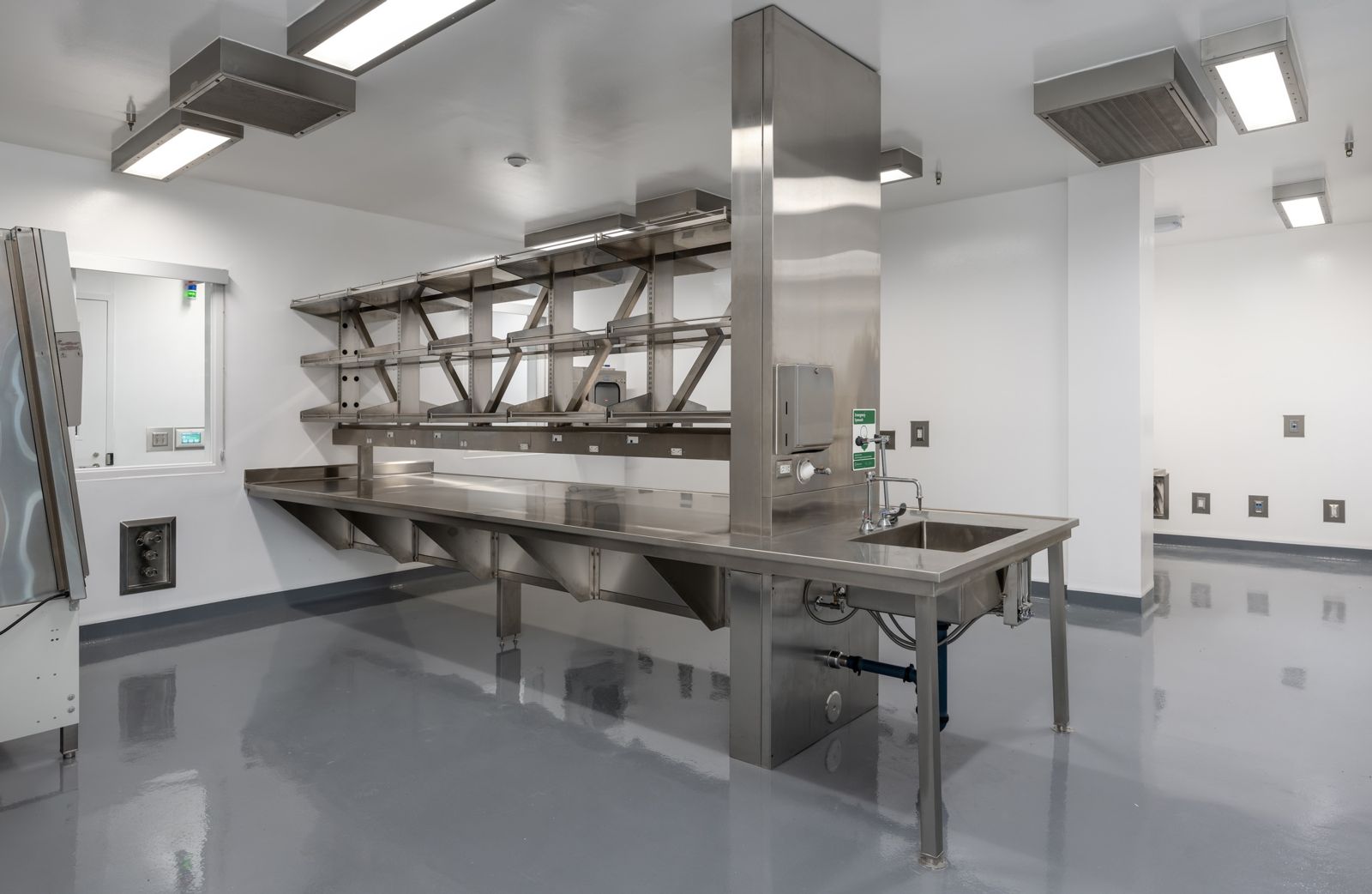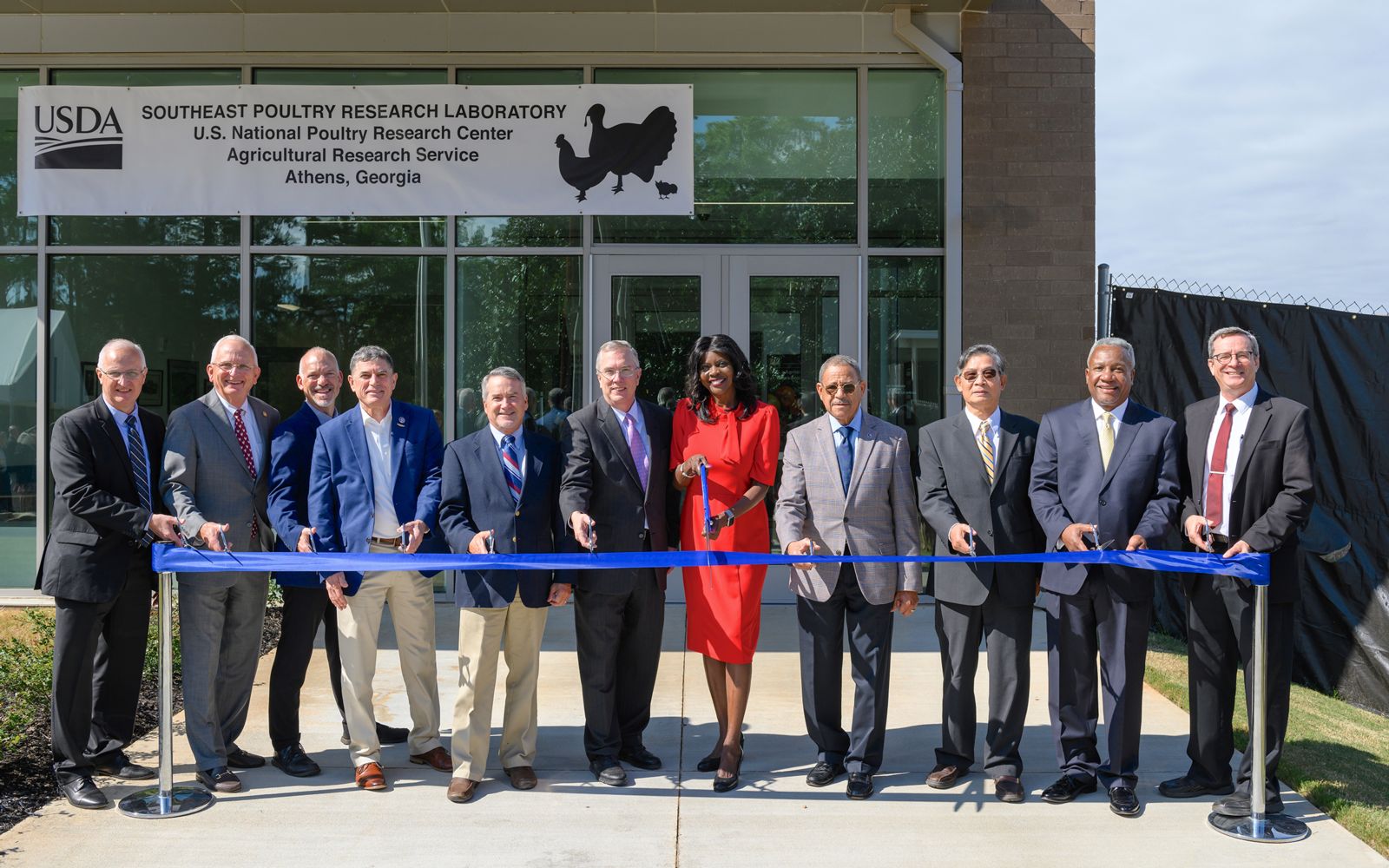GFB News Magazine
USDA Southeast Poultry Lab updated for 21st Century
Posted on November 23, 2022 7:00 PM
By Jennifer Whittaker, Georgia Farm Bureau
Don’t let the name of the USDA Southeast Poultry Research Laboratory (SEPRL) mislead you. The lab’s days of doing regional poultry research, as it did when established in 1962 to study air sacculitis in broilers, ended years ago.
SEPRL, a key part of the U.S. National Poultry Research Center, conducts research on viral poultry diseases to protect poultry flocks around the world and the international sale of poultry that feeds so many.
In October the USDA Agricultural Research Service (ARS) cut the ribbon for new facilities at the Athens lab adjacent to the University of Georgia. Two of three planned new buildings have been built and are operational.
When the third building is finished, SEPRL will be a 280,000 square-foot complex, making it the largest poultry research complex in the United States, USDA Under Secretary for Research, Education & Economics and USDA’s Chief Scientist Dr. Chavonda Jacobs-Young said.
What SEPRL does
SEPRL researchers developed the molecular tests used globally to diagnose avian influenza (AI) and Newcastle disease. The lab tracks outbreaks and the spread of viruses that cause AI and Newcastle, has developed vaccines for these viruses for emergency and commercial use, and conducts research to understand how to break the transmission cycle of the viruses. SEPRL researchers also study avian reoviruses, infectious bursal disease and Marek’s disease.
“The work of this lab and team has become more and more important. In the middle of an outbreak, they’re nimble enough to research the strain of a virus affecting birds in real time while also doing long-range work,” Georgia Poultry Federation President Mike Giles said. “It’s the people working in the building that make the difference. On behalf of Georgia’s poultry industry, I’d like to thank the lab researchers for their work to keep the poultry industry safe. The poultry industry appreciates the investment the USDA and Congress have made in this facility.”
Importance of SEPRL
The dedication ceremony highlighted the economic contribution poultry makes to Georgia’s economy and the importance of poultry research.
“The innovative and collaborative work done at this lab supports the $48.1 billion U.S. poultry sector that helps feed America and the world,” U.S. Rep. Sanford Bishop said.
Outgoing U.S. Rep. Jody Hice thanked UGA and USDA researchers for working together to protect the state’s poultry sector.
“Whenever there is an infectious disease within the poultry population, it has a ripple effect worldwide, which makes the research done at this facility all the more important,” Hice said. “The partnership between UGA and USDA researchers is a partnership we will benefit from for years to come.”

Autoclaves for sterilizing materials in the USDA Southeast Poultry Lab./Photo courtesy USDA
Georgia is the top poultry producing state in the U.S. Three of every four counties in the state have businesses involved in poultry or egg production, according to the USDA.
“As a proud representative of Gainesville, the Poultry Capital of the World, I’m keenly aware of supply chain disruptions that have occurred in recent years,” U.S. Rep. Andrew Clyde said. “Food security includes both food safety and availability. The work of this USDA lab has been critical in keeping the poultry industry running.”
Need for a new facility
When built in the 1960s, SEPRL was designed with multiple small buildings to keep experiments and researchers apart, Dr. David Suarez, SEPRL research leader for exotic & emerging avian viral diseases, explained.
“When I first started in 1995, we had at least 35 buildings,” Suarez recalled. “In the past 60 years high efficiency particulate air (HEPA) controls, building engineering and technology has improved so much we can now consolidate all our research buildings into three large buildings. It’s amazing to be given the opportunity to work in a facility of this caliber. The design of the new buildings is more employee friendly and makes it easier to collaborate with our colleagues.”
Thanks to the new facility, Suarez’s team, which researches exotic and emerging diseases like avian flu and Newcastle, has consolidated from three small buildings to one of the new ones. The endemic poultry viral team, led by Dr. John Dunn, that studies reoviruses, infectious bursal disease and Marek’s disease is housed in the second new building.
“The existing facility already leads the world in poultry research so imagine what our scientists can do with this improved facility,” USDA Under Secretary Dr. Jacobs-Young said. “We have a lot to look forward to at this new facility.”
New facility a team effort
“I’d like to thank Georgia’s U.S. Congressional delegation for its strong, strong support. This would not have happened without their securing funding and seeking support from their Congressional colleagues,” SEPRL Director Dr. David Swayne said.

The USDA Southeast Poultry Lab features high biocontainment equipment for safe research on exotic viruses of poultry. / Photo courtesy USDA
Swayne said the pre-design of the new complex dates to 2005 with SEPRL securing federal funding in 2015 and 2016 that allowed the lab to break ground in 2017.
“I was here for the groundbreaking ceremony held for this facility in November 2017, so it’s wonderful to be back here today to see the first two of the three buildings that will make up the lab completed,” outgoing Georgia Agriculture Commissioner Gary Black said. “It’s very important to recognize our federal partners who made this lab possible.”
Bishop recalled working on the initial efforts to modernize SEPRL that date back to the mid-2000s when initial design plans began.
“Poultry appropriations have always been important to me,” Rep. Bishop said. “As chairman of the House Appropriations Subcommittee for Agriculture, Rural Development, Food & Drug Administration and Related Agencies, I’m glad to work with my colleagues on both sides of the aisle to make sure USDA Agricultural Research Service labs get the funding they need.”
Dr. Jacobs-Young, who has been part of the USDA effort to update the SEPRL facility since talks began, said, “I think of the process of building this facility like a relay race. There are many of us here today who have worked to get this facility built for years.”

U.S., Georgia & Athens officials joined USDA Chief Scientist and Under Secretary Dr. Chavonda Jacobs-Young, center, and USDA Agricultural Research Service leaders Oct. 4 to celebrate new buildings at the Southeast Poultry Research Laboratory. / Photo courtesy USDA